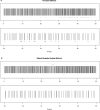Detection of bursts and pauses in spike trains
- PMID: 22939922
- PMCID: PMC3473113
- DOI: 10.1016/j.jneumeth.2012.08.013
Detection of bursts and pauses in spike trains
Abstract
Midbrain dopaminergic neurons in vivo exhibit a wide range of firing patterns. They normally fire constantly at a low rate, and speed up, firing a phasic burst when reward exceeds prediction, or pause when an expected reward does not occur. Therefore, the detection of bursts and pauses from spike train data is a critical problem when studying the role of phasic dopamine (DA) in reward related learning, and other DA dependent behaviors. However, few statistical methods have been developed that can identify bursts and pauses simultaneously. We propose a new statistical method, the Robust Gaussian Surprise (RGS) method, which performs an exhaustive search of bursts and pauses in spike trains simultaneously. We found that the RGS method is adaptable to various patterns of spike trains recorded in vivo, and is not influenced by baseline firing rate, making it applicable to all in vivo spike trains where baseline firing rates vary over time. We compare the performance of the RGS method to other methods of detecting bursts, such as the Poisson Surprise (PS), Rank Surprise (RS), and Template methods. Analysis of data using the RGS method reveals potential mechanisms underlying how bursts and pauses are controlled in DA neurons.
Copyright © 2012 Elsevier B.V. All rights reserved.
Figures










References
-
- Cateau H, Reyes AD. Relation between single neuron and population spiking statistics and effects on network activity. Phys Rev Lett. 2006;96:058101. - PubMed
-
- Chergui K, Suaud-Chagny MF, Gonon F. Nonlinear relationship between impulse flow, dopamine release and dopamine elimination in the rat brain in vivo. Neuroscience. 1994;62:641–645. - PubMed
-
- Chergui K, Charlety PJ, Akaoka H, Saunier CF, Brunet JL, Buda M, Svensson TH, Chouvet G. Tonic activation of NMDA receptors causes spontaneous burst discharge of rat midbrain dopamine neurons in vivo. Eur J Neurosci. 1993;5:137–144. - PubMed
-
- Christoffersen CL, Meltzer LT. Evidence for N-methyl-D-aspartate and AMPA subtypes of the glutamate receptor on substantia nigra dopamine neurons: possible preferential role for N-methyl-D-aspartate receptors. Neuroscience. 1995;67:373–381. - PubMed
-
- De Schutter E, Steuber V. Patterns and pauses in Purkinje cell simple spike trains: experiments, modeling and theory. Neuroscience. 2009;162:816–826. - PubMed
Publication types
MeSH terms
Grants and funding
LinkOut - more resources
Full Text Sources

